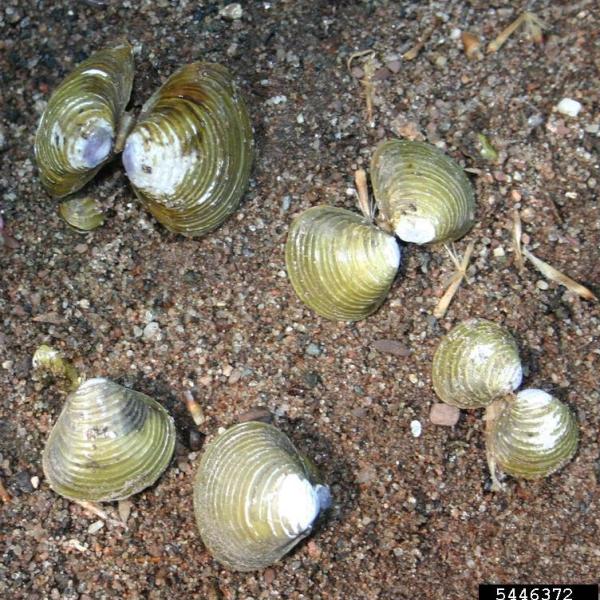
News Source
Grand Isle, VT – When a volunteer pulled a suspicious clam from the lakebed in Whitehall, New York, as part of a routine monitoring program last month, they immediately reported the find to lake scientists. Further analysis confirmed the first known occurrence of invasive golden clam (Corbicula fluminea) in Lake Champlain.
The clam, which is native to the eastern Mediterranean and Asia, can crowd out native species and increase occurrences of cyanobacteria blooms.
The volunteer, working with the Champlain Aquatic Invasive Species Monitoring Program (CHAMP), made the discovery while conducting a survey at the South Bay boat launch, which is owned and operated by the New York State Department of Environmental Conservation (NYSDEC).
The volunteer reported the find to the Lake Champlain Committee, which operates the monitoring program. Staff from the Patrick Leahy Lake Champlain Basin Program (LCBP) and NYSDEC later confirmed the specimen as golden clam, which has been in the region since 2008 but was previously unknown in Lake Champlain.
The Lake Champlain Rapid Response Task Force met last week to review potential next steps in responding to the discovery. The LCBP and NYSDEC are assessing the significance of this introduction and conducting further surveys to define the extent of this population.
An established presence of golden clam would bring the number of known nonnative and aquatic invasive species in Lake Champlain to 52. This finding underscores the importance of ongoing efforts to protect the lake’s ecosystem and native species through early detection of invasive species.
The golden clam is hermaphroditic, meaning a single individual can reproduce and start a new population in previously uninfested waters. The species is known to reproduce quickly in other waterbodies in northeastern North America.
Golden clam was confirmed in the region in 2008 in Hudson Falls, New York, near lock C9 of the Champlain Canal. It has since become established in Lake George, New York, in 2010 and Lake Bomoseen, Vermont, in 2016. All three waterways drain into the southern portion of Lake Champlain.
The Lake Champlain Committee’s CHAMP initiative is supported with funding from the U.S. Environmental Protection Agency through a grant from the LCBP and NEIWPCC. The State of New York, State of Vermont, and additional partners developed the program to increase the number of trained people looking for aquatic invasive species along Lake Champlain shorelines.
The LCBP coordinates the Lake Champlain Rapid Response Task Force, which includes experts from New York, Vermont, Québec, and the U.S. federal government. The task force was established to respond to reports of new aquatic invasive species or the spread of an existing aquatic invasive species to a new body of water in the watershed.
Meg Modley, Aquatic Invasive Species Management Coordinator for the LCBP, said, “Lake Champlain is a large lake, and volunteer monitoring can play a critical role in finding new or suspicious species. The discovery of golden clam reinforces the need for all visitors to Lake Champlain to Clean, Drain, and Dry their boats, trailers, and equipment to prevent the spread of aquatic invasive species.”
Susan Sullivan, NEIWPCC Executive Director, said “Aquatic invasive species, such as the golden clam, pose a serious threat to the Lake Champlain ecosystem. We remain committed to preventing the spread of these species by working with our partners in the Lake Champlain Basin.”
“The discovery of golden clam by one of the Lake Champlain Committee’s Champlain Aquatic Invasive Species monitors reinforces the importance of the program to AIS spread prevention” said Lake Champlain Committee Executive Director Lori Fisher. “We’re grateful for the volunteer’s swift response and LCBP’s funding for this important program and hope more community members will sign up to volunteer. Humans have the greatest influence on AIS spread and the monitoring program is a way to play an active role in spread prevention.”
Laurie Earley, Project Leader, Lake Champlain Fish and Wildlife Conservation Office, U.S. Fish and Wildlife Service, said, “The detection of golden clam in Lake Champlain emphasizes the need for the Rapid Response Task Force to continue to work together on early detection, prevention, and outreach. The Service will support NYS DEC and the LCBP through the response process and reinforce the importance of Clean, Drain, Dry.”
Kim Jensen, Aquatic Biologist at the Vermont Department of Environmental Conservation, said, “Community scientist programs like CHAMP are an effective model to assist state agencies in the early detection of invasive species. As the Lake Champlain Rapid Response Task Force members gather more information on whether a successful effort can be made to manage this new population, reports from volunteers provide an essential tool in spread prevention efforts.”
To learn more about the golden clam and aquatic invasive species management, visit the LCBP Aquatic Invasive Species web page.